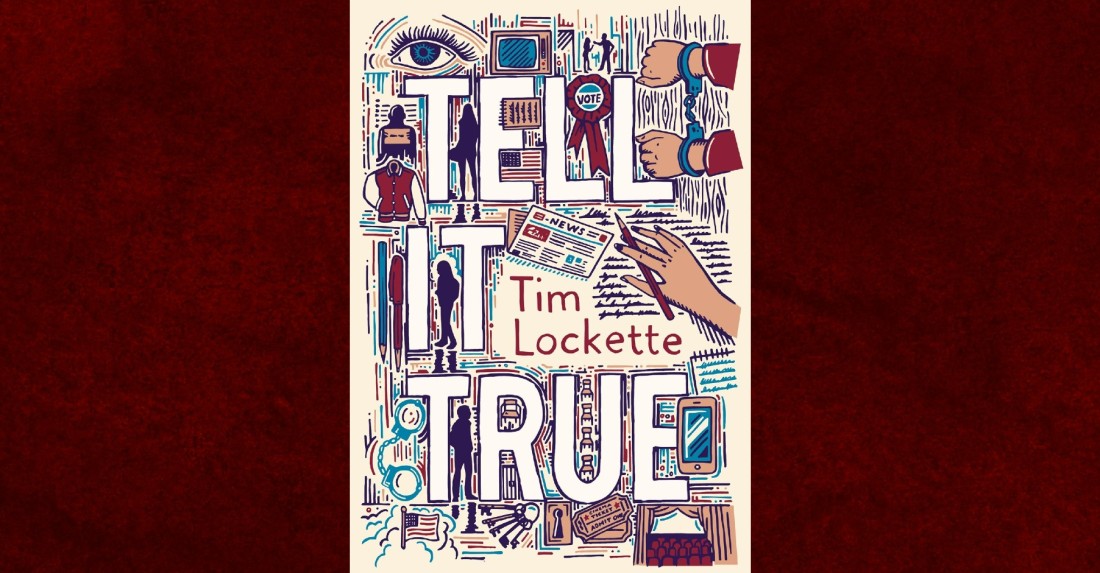When I was a freshman in college, the opinion editor of our newspaper published an editorial that listed every major student group on campus alongside the meanest, nastiest stereotypes about each of them. It was designed to get people to pick up a newspaper, to read it, and to respond. But it was also cruel.
I remember the article nearly twenty years later because of the outrage it sparked — and because I had met the opinion editor and knew him to be a kind, if eccentric, individual. He had made a conscious decision to be cruel in order to evoke a reaction. But was that the right choice? How do we know when the line has been crossed from reporting into bullying? And what standards should student journalists — and all journalists — be expected to uphold?
Tim Lockette’s young adult novel, Tell It True, released in paperback this month, explores these questions. Lisa Rives, the book’s protagonist, is a fifteen-year-old with a “too-cool-for-school” attitude who gets roped into running her school’s newspaper by her best friend, the paper’s cartoonist. Lisa’s first action as editor-in-chief is to publish an illustration of her teacher alongside a new nickname, “Blanderson,” an amalgam of the teacher’s hyphenated married name, Blandings-Sanderson. Blanderson, the faculty advisor for the school newspaper, admonishes Lisa for her stunt:
The things you say have meaning. You can change someone’s name. You’ve already changed my name just by showing Preethy’s cartoon around. Who in the world has the power to change someone’s name without asking? A bully, that’s who.
As Lisa comes to understand the power of the tool now at her disposal, she grows from grudging editor-in-chief to the paper’s champion and soon finds herself in the middle of a fight for representation in the town’s biggest news story: the execution of a convicted murderer.
Throughout the narrative, Lockette’s writing style emphasizes dialogue without grounding conversations in physicality, giving his scenes a “newsroom talking-heads” feel. Stylistically, this choice makes sense for a novel about journalism, though it is at times disorienting, and I sometimes struggled to pick up on the nuances of each character’s actions and reactions.
In addition to dialogue, Lockette utilizes Lisa’s interiority to convey character, particularly in his depictions of Houser, the murderer, and Rhee Ann, the victim’s sister. Despite their status as secondary characters, both are nuanced and truthful. Lockette describes Houser through Lisa’s eyes as looking “like he’d seen something that had unnerved him. Not something that had really happened, like, in front of him, but something inside himself.” Rhee Ann, on the other hand, is both regretful and sad about her sister’s death, but in the two decades that have passed, finds she doesn’t miss her as much as she misses “the kids [she assumed] she would have had.” In this way, Lockette convincingly portrays both characters’ complex natures, an impressive feat for a slender novel.
Lockette himself is a seasoned journalist with a specific focus on the death penalty, and his knowledge and passion ring clear throughout his novel. Tell It True teaches as much as it entertains, and the author imparts his knowledge through Blanderson, who regularly waxes poetic about the responsibilities of a journalist: “So many kids come into my class thinking reporters are ghouls, that they’re crass and bloodthirsty. Being like that is not our job. Sometimes our job is to be more human than the circumstances.” Though the novel does sometimes stray too far into the instructional, blending the author’s and narrator’s voices, that is forgivable in a teaching setting, perhaps alongside a unit about ethical journalism and the death penalty.
Occasionally, the narrative feels hurried, a mad rush to the scene of the execution; as a consequence, I had trouble believing the change of heart Lisa experiences in such a short span of time. I also wished we saw more development between some of the characters, such as Lisa’s parents, and especially between Lisa and her best friend, Preethy, whose friendship seems fraught with unexplored tension. That said, at no point did I feel the novel lagged or lacked momentum. In classic journalist style, every scene has a purpose; Lockette does not indulge in superfluous text.
Overall, despite — and because of — its journalistic heart, Tell It True by Tim Lockette is an enjoyable read with an engaging plot and an interesting main character. It’s full of the kind of heartfelt wisdom that will make a profound impact on teenage readers, who will relate easily to Lisa and Preethy and the rest of the cast. Readers will finish this book feeling inspired. As Lew East, one of Lisa’s mentors, reminds her: “There aren’t small stories or small papers. Anybody can shake things up if they work hard enough.”
FICTION
Tell It True
By Tim Lockette
Triangle Square
Published September 28, 2021
Paperback December 26, 2023

